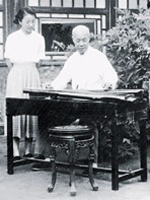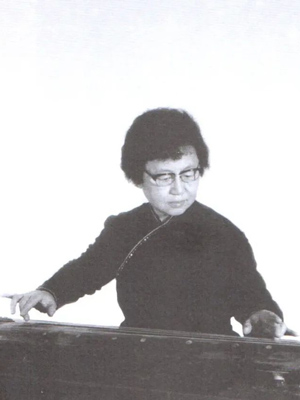|
T of C
Home |
My Work |
Hand- books |
Qin as Object |
Qin in Art |
Poetry / Song |
Hear, Watch |
Play Qin |
Analysis | History |
Ideo- logy |
Miscel- lanea |
More Info |
Personal | email me search me |
| Qin Biographies John Thompson Discographies | 首頁 |
|
20th Century Guqin Specialists
1
|
近代琴家
Top: Sun Yü-Ch'in; Bottom: Tong Kin-Woon 2 |
 Linked here are pages for several guqin specialists who have had particularly significant impact on my work. For further sketches see:
Linked here are pages for several guqin specialists who have had particularly significant impact on my work. For further sketches see:
The footnotes below 3
Sitong Shenpin players (people recorded as part of Zha Fuxi's guqin work beginning 1955)
Other CDs featuring silk strings
In general to find a particular name, it may be most convenient to use the search site function.4
- 陳長林 Chen Changlin (1915-1990)
One of the most prolific players, with 105 separate tracks recorded in this 8 CD set - 高羅佩 Gao Luopei (R. H. Van Gulik; 1915-1967)
His Lore of the Chinese Lute remains the best published introduction to guqin history and lore - 管平湖 Guan Pinghu (1897-1967)
Near-legendary qin master; prolific repertoire - 盧家炳 Lo Ka-Ping (1896-1980)
Qin collector, composer and teacher in Hong Kong- 容克智 Rong Kezhi (Hammond Yung)
Heir in Hong Kong of the 容氏家族琴學傳承 Rong Family Tradition- 孫毓芹 Sun Yuqin (Sun Yü-Ch'in; 1915-1990)
My original teacher in Taiwan, 1974 - 76- 唐健垣 Tang Jianyuan (Tong Kin-Woon)
My advisor in Hong Kong, 1976 - 2000- 王鐸 Wang Duo; 1938- )
Inheritor of the Wumen Qin school of Suzhou, silk string advocate, reconstructionist.- 葉世強 Ye Shiqiang (Yeh Shih-Ch'iang; 1926-2012)
He made my first qin.- 查阜西 Zha Fuxi (1895-1976)
His Guqin Work of 1956 is the basis for modern research on the qin - 容克智 Rong Kezhi (Hammond Yung)
Several more are briefly introduced below and under the introduction to Zha Fuxi's guqin work ("professional players").
Footnotes (Shorthand references are explained on a
separate page)
1.
20th Century Guqin Specialists
The focus of this website is guqin in pre-modern times. Thus this section is very much incomplete.
As for "qin specialists", the Chinese term 琴家 qin jia refers not just to players but also scholars, qin makers and others.
(Return)
2.
Sun Yü-Ch'in (my teacher) and Tong Kin-Woon (my advisor)
Images 41 and 42 at the front of Dr. Tong's
Qin Fu, B.
(Return)
3.
20th century guqin specialists
This footnote is currently reserved for brief comments on guqin specialists also mentioned elsewhere on this site.
- 汪孟舒 Wang Mengshu (1887-1969; further)
- 烏絲闌指法釋 Wulisan Zhifa Shi (Wusilan Finger Technique Explanations)
- 樂譜琴史校 Yuepu Qinshi Jiao (edited version of Zhu Changwen's Qin History
- 太音大全集校注 Taiyin Daquanji Jiaozhu (edited version of this Song dynasty compendium)
- 許健 Xu Jian (1923-2017; see also here and here)
- 王迪 Wang Di (1926 - 2005; Chinese Wiki)
| Wang Mengshu (1950s) |
 Wang Mengshu, 字希董 style name Xidong, born in the late 19th century, was a noted qin player, painter, calligrapher and book collector. He studied qin with Ye Shimeng and had two qin said to date from the Tang dynasty: Spring Thunder (春雷 Chun Lei) and Dragon Intoning from Dried Wood (枯木龍吟 Kumu Long Yin, often translated simply as "Dragon's Moan"). He relied on many of his old books to write his 烏絲闌指法釋 (Wusilan Zhifa Shi, Beijing 1955), which explains finger techniques found in the Tang dynasty long hand tablature for 幽蘭 You Lan. At least two recordings of him playing qin can be heard:
Guanghan Qiu and
Qingye Yin; both seem to be reconstructions.
Wang Mengshu, 字希董 style name Xidong, born in the late 19th century, was a noted qin player, painter, calligrapher and book collector. He studied qin with Ye Shimeng and had two qin said to date from the Tang dynasty: Spring Thunder (春雷 Chun Lei) and Dragon Intoning from Dried Wood (枯木龍吟 Kumu Long Yin, often translated simply as "Dragon's Moan"). He relied on many of his old books to write his 烏絲闌指法釋 (Wusilan Zhifa Shi, Beijing 1955), which explains finger techniques found in the Tang dynasty long hand tablature for 幽蘭 You Lan. At least two recordings of him playing qin can be heard:
Guanghan Qiu and
Qingye Yin; both seem to be reconstructions.
Much of Wang Mengshu's work been compiled and edited by 楊元錚 Yang Yuanzheng in 古吳汪孟舒先生琴學遺著 (Valued Writings of Qin Studies by Mr. Wang Mengshu of Old Wu. Beijing). This includes edited versions of,
and numerous other works. His You Lan materials were originally published in this mimeographed version.
| Xu Jian's CD cover |
 Along with Wang Di (see below), Xu Jian was a leading assistant to Zha Fuxi in his guqin research project, as discussed
here. In 1997 he flattered me with
a review of my first CD, Music Beyond Sound. In the early 2000s a student helped me translate a good part of his Qin Shi Chu Bian. On another occasion I had the opportunity to meet him and discuss his work. He showed me transcriptions he had made of all the music in quite a number of early qin handbooks, including Shen Qi Mi Pu and Xilutang Qintong. It would be interesting to know what happened to these transcriptions. It is my understanding he may have played through many or all them to a certain extent while doing the transcriptions, but only learned a few of them fluently, and only recorded a few of them.
Along with Wang Di (see below), Xu Jian was a leading assistant to Zha Fuxi in his guqin research project, as discussed
here. In 1997 he flattered me with
a review of my first CD, Music Beyond Sound. In the early 2000s a student helped me translate a good part of his Qin Shi Chu Bian. On another occasion I had the opportunity to meet him and discuss his work. He showed me transcriptions he had made of all the music in quite a number of early qin handbooks, including Shen Qi Mi Pu and Xilutang Qintong. It would be interesting to know what happened to these transcriptions. It is my understanding he may have played through many or all them to a certain extent while doing the transcriptions, but only learned a few of them fluently, and only recorded a few of them.
As for recordings, Xu Jian apparently only made a few of them, but they show him to have been a very accomplished player. This can be heard by listening to the CD made in 2016 by Hugo (陽關三疊 Yang Guan San Die, HRP 7344-2) with Xu Jian playing qin, sometimes together with others (details).
Born in Hebei, Xu Jian studied at the 重慶青木關音樂學院 Qingmuguan Conservatory of Music in Chongqing from 1942 to 1946, then taught there until 1954 when he went to the Central Conservatory in Beijing to study guqin. There he studied with Guang Pinghu and became involved in Zha Fuxi's guqin research project.
After this he continued to work at the Music Research Institute of the China Academy of Arts, producing a significant body of research and eventually becoming Vice President of the Beijing Guqin Research Association.
See also zh.wikipedia, baike.baidu.hk and this obituary.
|
|
Wang Di playing qin |
 Along with Xu Jian (above), Wang Di was a leading assistant to Zha Fuxi in his guqin research project, as discussed here. Originally a student of Guan Pinghu, after her work in 1956 with Zha Fuxi on his nationwide survey of qin players (q.v.) she continued with guqin research for nearly 40 years in the Folk Music Research Institute of the China Arts Research Academy. Her work on qin songs resulted in at least two books of transcriptions, outlined here; they are also mentioned in the Qin Bibliography.
Along with Xu Jian (above), Wang Di was a leading assistant to Zha Fuxi in his guqin research project, as discussed here. Originally a student of Guan Pinghu, after her work in 1956 with Zha Fuxi on his nationwide survey of qin players (q.v.) she continued with guqin research for nearly 40 years in the Folk Music Research Institute of the China Arts Research Academy. Her work on qin songs resulted in at least two books of transcriptions, outlined here; they are also mentioned in the Qin Bibliography.
Although she was a qin player and teacher, there do not seem to be any recordings of her as part of the collections Sitong Shenpin or Juexiang, other than a video of her playing 漁歌 Yu Ge with an orchestra in Taiwan. This can be found in several places online, as can this recording of her playing the modern 流水 Liu Shui.
On this site she is mentioned mostly in connection with her work on two collections of books that have her transcriptions of qin songs. References on this site to her work mostly are linked from these books, Qin Songs (staff notation only) and String Songs Elegant in Sound (number notation and 2 CDs). She herself apparently does not play on the recordings.
Stephen Jones has further information about her on a blog page in his series The qin zither under Maoism.
See also professional players under Zha Fuxi guqin work.
(Return)
4.
Finding more biographical sketches
This site originated with and continues to have a focus on melodies surviving from Ming dynasty publications. In 2019-2021 getting the amazing compendiums Sitong Shenpin (30 CDs) and Jue Xiang have prompted me to add this information sort of after the fact. As a result I have not yet figured out the best way to incorporate this material into the entire site. To the extent that they are included here, this section can be compared to the sections with biographies of earlier players. In connection with the two recordings I have listed all the people for whom I have found recordings in various sources. However, I can only gradually add the content from the original Chinese sources.
Below will be some further people whose biographical outlines are not included elsewhere.
裴鐵俠 Pei Tiexia (1884 - 1950; 百度百科)
Pei Tiexia's Shayan Qinpu (1946) is the last qin handbook to have been published in China before 1949. Like Pei Jieqing, Pei Tiexia was also from Chengdu but their relationship, if any, is unclear: the early play Shen Caonong apparently studied with Pei Tiexia but melodies he is recorded having played are said to follow the tablature of Pei Jieqing. I have not yet found any recordings said to be from Pei Tiexia's handbook and there are no known recordings by Pei Tiexia himself.An early 泛川派 Fanchuan school player, Pei was also connected to the 清川派 Qingchuan and 虞山派 Yushan Schools. He apparently came from a wealthy family and is said to have owned many old qins, including two famous Lei family qins; because of the latter his studio (and/or home, in Shayan district) had the name 雙雷齋 Studio of a Pair of Lei. He studied qin with several masters including Yang Shibai and 張瑞山弟子 Cheng Fu, a disciple of Zhang Ruishan. Subsequently he became an active and influential player in the first half of the 20th century, mentioned in connection with the 今虞琴社 Jinyu Qinshe (Shanghai; see in Qin Fu I/1430, which lists a repertoire somewhat different from the content of his handbook) and 律和琴社 Lühe Qin She (Chengdu) in the 1930s. He apparently died by suicide in 1950 (several other family members also having died), first destroying his two Lei family instruments (others in his collection apparently survived); from this his demise has been compared with the disappearance during the Cultural Revolution of Pu Xuezhai (see, e.g., here).
Once again, to find information about others people please
search this site.
(Return)
Return to the Top or to the
Guqin ToC